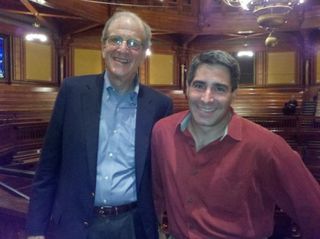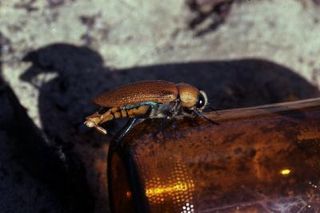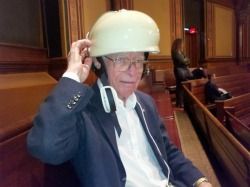Ig Nobel Prize Winners Make Hilarious Contributions to Science
Intro

Every year in Norway, Nobel Prizes are awarded to scientists who have made outstanding contributions to human knowledge. Also every year, but at a far less formal ceremony in Cambridge, Mass., "Ig Nobel" Prizes are given to scientists who have made outstanding, but also hilarious, contributions to various scientific fields.
On Thursday, Sept. 29 at 7:30 p.m., the 2011 Ig Nobel Prizes were announced. Drumroll, please!
Medicine Prize

In the past year, two separate groups studied who having the urge to pee can affect a person's decision-making. The first group found that people are less impulsive, and thus make better decisions, when they sort of have to pee. The second group found that when people really, really have to pee, their cognitive abilities break down, and they get a lot worse than they normally are at being able to recall simple sequences of playing cards.
"I think it's an upside-down U-shape," said Mirjam Tuk of the University of Twente and the Insead Business School in the Netherlands, who was part of the first group. She thinks people make good decisions when they sort of have to urinate, and then their decisions get much worse when they really have to urinate. [10 Weird Things People Do Every Day (and Why )]
Peter Snyder, the neurologist at Brown University who led the first group, said studying people when they need to urinate is a good way of investigating the cognitive affects of pain. Because the pain can be relieved with the flip of a zipper and because it's the kind of pain we're all at least somewhat familiar with dealing with it's a humane research tool.
Biology Prize

Twenty years ago, Australian biologists Darryl Gwynne and David Rentz noticed a preponderance of male beetles trying to mate with beer bottles of a certain brand, which were often scattered on the side of the road. The beetles were so desperate to mate with the bottles that they would often end up getting killed by ants, which killed the beetles as they went after the drops of beer left in the bottles. But even partial carcasses of dead beetles lying around didn't put off future suitors.
Gwynne and Rentz realized that the beer bottles were exactly the same brown color as female beetles of the species, and ridges that circled the bottom of the bottles cast shadows that resembled a pattern found on the females. These two coincidences were enough to attract the males, who have been programmed by evolution to seek the biggest female they could find even if that meant beer-bottle-sized. The biologists surmised that males can afford to make sexual mistakes, because they have a great deal of sperm, whereas females (of any species) make few sexual mistakes, as they have limited eggs.
The researchers wrote a letter to the beer company in question and told them of his finding. There was no response. Finally, 20 years down the road, they have gotten the recognition they deserve in the form of the Ig Nobel Prize for Biology. [Two-Headed Dogs and Cyborg Monkeys: The 6 Craziest Animal Experiments ]
Psychology Prize

Despite the commonly uttered phrase, we don't really breathe sighs of relief. Neither do we sigh when we're sad, as dictionary definitions would have you believe. In fact, we sigh when we're ready to give up, as was recently discovered by Karl Teigen of the University of Oslo in Norway.
Realizing that no psychologists had ever studied the emotional cause of sighs before, Teigen and his colleagues investigated participants' breathy exhales in a series of experiments. He found that when people saw someone else sigh, they almost always incorrectly assumed that that person was feeling sad. When people sigh themselves, on the other hand, they said it was because they were ready to throw in the towel. In short, regardless of how socially attuned humans are to the thoughts and feelings of others, people completely misinterpret the reason for sighing.
To prove that sighs are tied to frustration and giving up, Teigen did an experiment in which he asked participants to attempt puzzles that were unsolvable. His results? "They tried and they sighed; they tried and they sighed," he told Life's Little Mysteries. The research, published in the Scandinavian Journal of Psychology, earned Teigen the 2011 Ig Nobel Prize.
Peace Prize

{youtube V-fWN0FmcIU}
Arturas Zuokas, the mayor of Vilnius, Lithuana received the Ig Noble Peace Prize this year. To stop people from illegally parking cars in his city's streets, he started a viral video campaign showing himself driving an armored tank over a Mercedes that is (illegally) blocking a bike lane. "It's very popular everywhere. On Youtube it has almost 7 million hits!" Zuokas said. Even better, the campaign worked with drivers more mindful of their actions, the city of Vilnius has seen the problem of illegal parking significantly "curbed."
Chemistry PrizeChemistry Prize

Too much wasabi on your sushi will pop your eyes wide open. Now, we know it will wake you up during a fire, too. A group of scientists from Shiga University of Medical Science in Japan received this year's Ig Nobel Chemistry Prize for inventing a "wasabi alarm," which sprays wasabi particles upon detection of fire in order to awaken sleeping people. They even discovered the ideal wasabi density that should be used. After all, too much wasabi in the air would make for an emergency situation of its own.
"The next application will be to use wasabi spray to reduce the uncomfortable smell of shoes," said prize recipient Makoto Imai.
Public Safety Prize

In the 1960s, John Senders of the University of Toronto in Canada pioneered the study of distraction during driving in an experiment that surely would not get approved today. He built a helmet with a visor that the wearer can move up or down at will, and had people wear the helmet while driving a car. Participants were told to keep the visor down driving blindly until they felt the need to see the road in front of them, at which point they would raise the visor until they felt comfortable lowering it again. "Most people would say this was dangerous, but, you see, there were no institutional review boards at the time," Senders told Life's Little Mysteries.
By measuring how much time drivers spent with the visors up and down, and comparing that to the amount of traffic on the road at the time, Senders found that drivers needed to pay more attention to the road, the busier it is. This may be exactly what you would expect but Senders gathered the data to prove it.
"[The paper] remained essentially unread for 30 years," Senders said. Then, with the invention of cell phones and the driving distractions they presented, someone discovered the paper. For taking risks in order to gain a scientific understanding of how much attention people must pay to road in order to drive safely, Senders was awarded the Ig Nobel Prize for Public Safety.
Physiology Prize

Yawning is contagious in humans, that is. Cognitive biologists working at the Leopold Franzens University in Austria found that yawning is not contagious among red-footed tortoises.
Why, you may wonder, was this question worth investigating? Well, the scientists were ultimately interested in finding out whether social intelligence in humans has evolved because we are social animals, or whether social intelligence is learned. "The tortoise is an ideal model system because it is completely solitary. So the question is: "Is social behavior needed to have social intelligence?" said biologist Ludwig Huber.
Results were mixed. In one experiment, the tortoises, together with other tortoises for the first time in their lives, learned to look where other tortoises were looking a kind of social intelligence. However, they did not yawn when other tortoises yawned. "We think that's because contagious yawning requires empathy, which is a higher form of social intelligence," Huber said.
Mathematics Prize

Mathematical prizes were awarded to a number of people who had, at various times in the past, wrongly predicted the end of the world. Harold Camping, the radio talk show host whose numerical interpretation of the Bible led him to predict that the end of the world would come in May 21, 2011, was among the winners. The Ig Nobel Committee awarded the prize to these doomsday predictors "for teaching the world to be careful when making mathematical assumptions and calculations," they said in a press statement.
None of the mathematics honorees accepted invitations to attend the ceremony.
Physics Prize

A group of physicists in the Netherlands wrote a paper explaining why discus throwers become dizzy while hammer throwers do not. Their paper earned them a nod from the Ig Nobel Committee.
Literature Prize

If you want to be a high achiever but you tend to procrastinate, always work on something important, using it as a way to avoid doing something that's even more important. That's the lesson of John Perry, winner of the Ig Nobel Prize for Literature, whose advice on "structured procrastination" was published in the Chronicle for Higher Education in the 1990s.
Follow Natalie Wolchover on Twitter @nattyover. Follow Life's Little Mysteries on Twitter @llmysteries, then join us on Facebook.
Sign up for the Live Science daily newsletter now
Get the world’s most fascinating discoveries delivered straight to your inbox.
Natalie Wolchover was a staff writer for Live Science from 2010 to 2012 and is currently a senior physics writer and editor for Quanta Magazine. She holds a bachelor's degree in physics from Tufts University and has studied physics at the University of California, Berkeley. Along with the staff of Quanta, Wolchover won the 2022 Pulitzer Prize for explanatory writing for her work on the building of the James Webb Space Telescope. Her work has also appeared in the The Best American Science and Nature Writing and The Best Writing on Mathematics, Nature, The New Yorker and Popular Science. She was the 2016 winner of the Evert Clark/Seth Payne Award, an annual prize for young science journalists, as well as the winner of the 2017 Science Communication Award for the American Institute of Physics.

